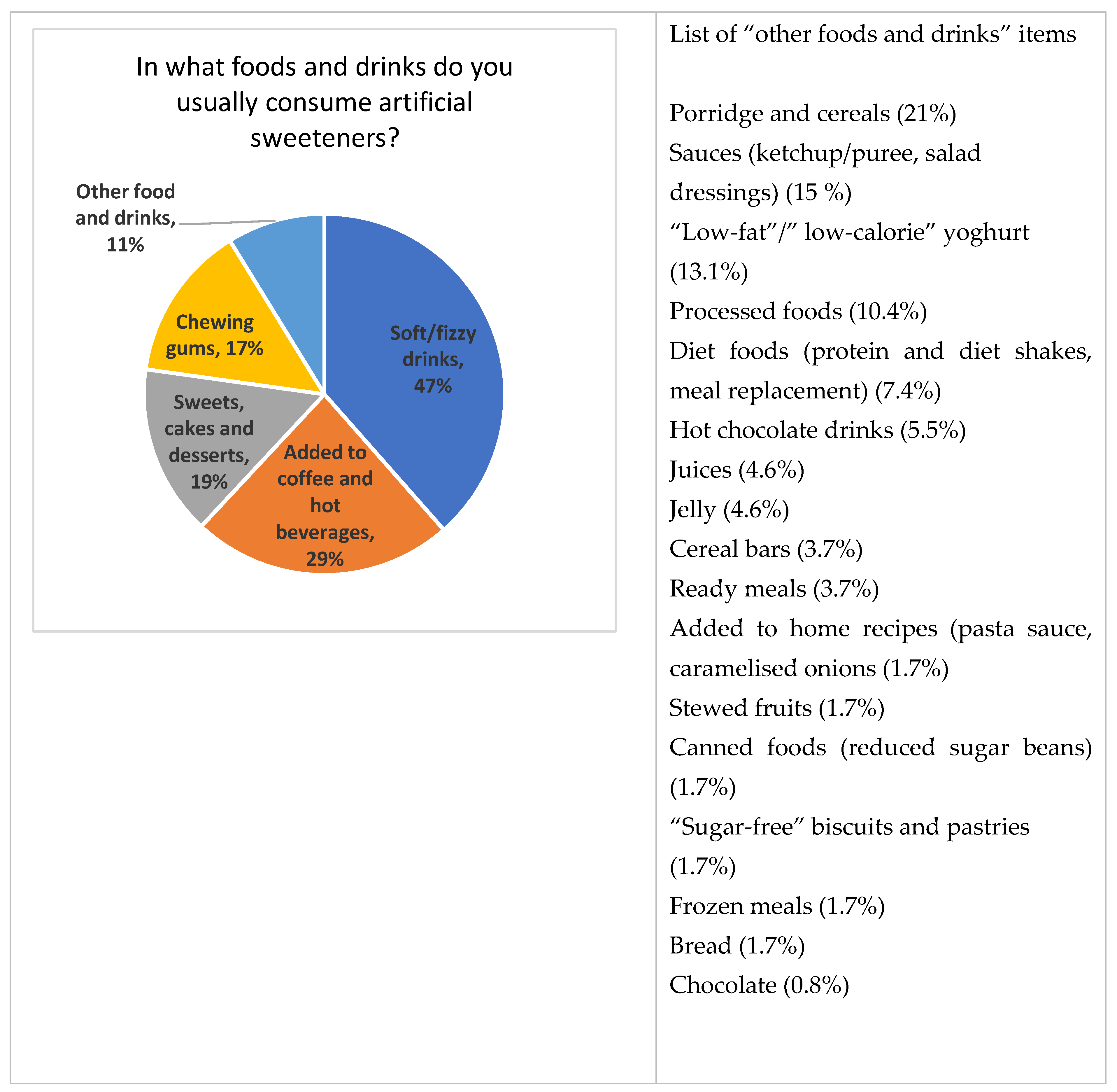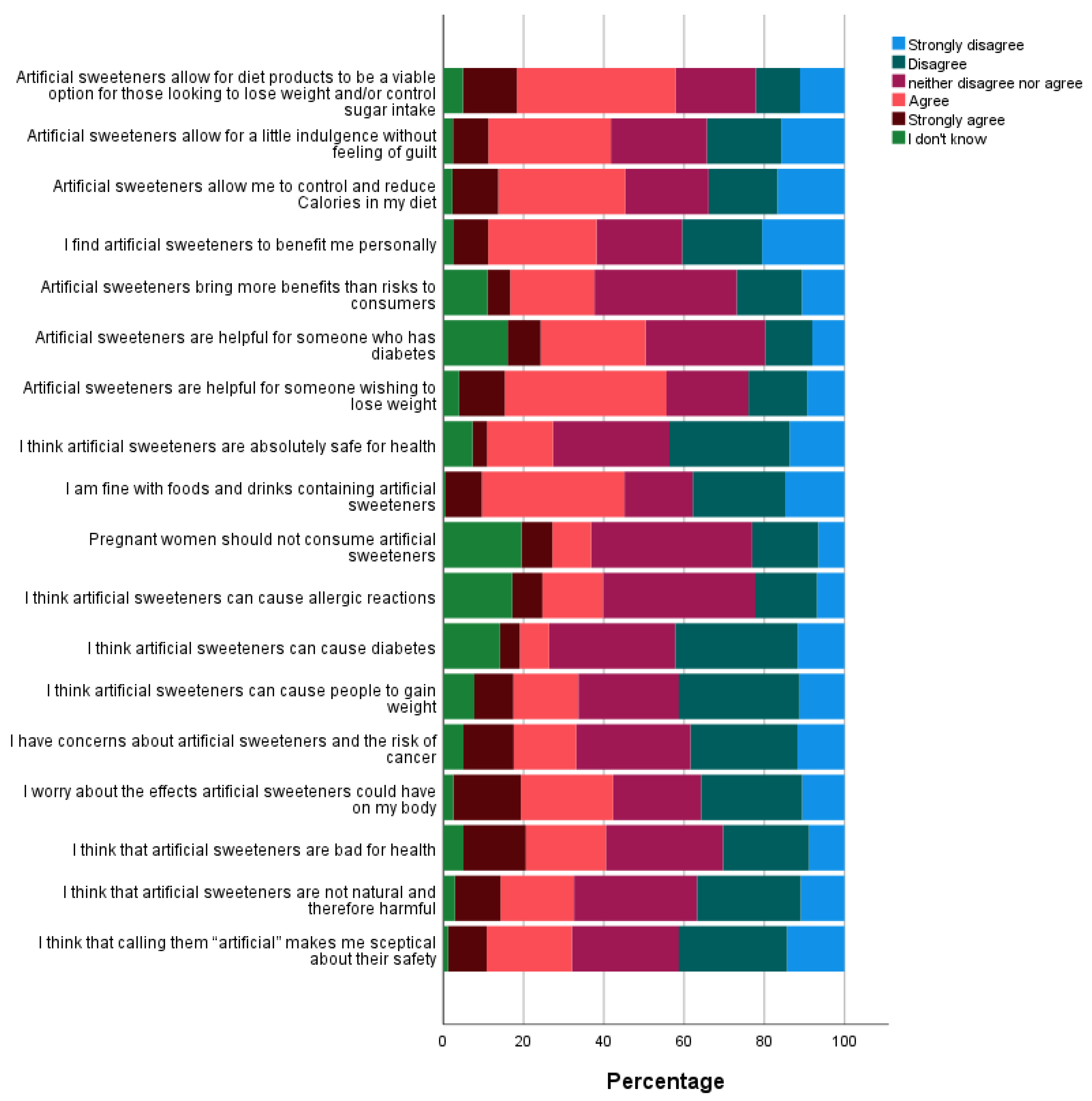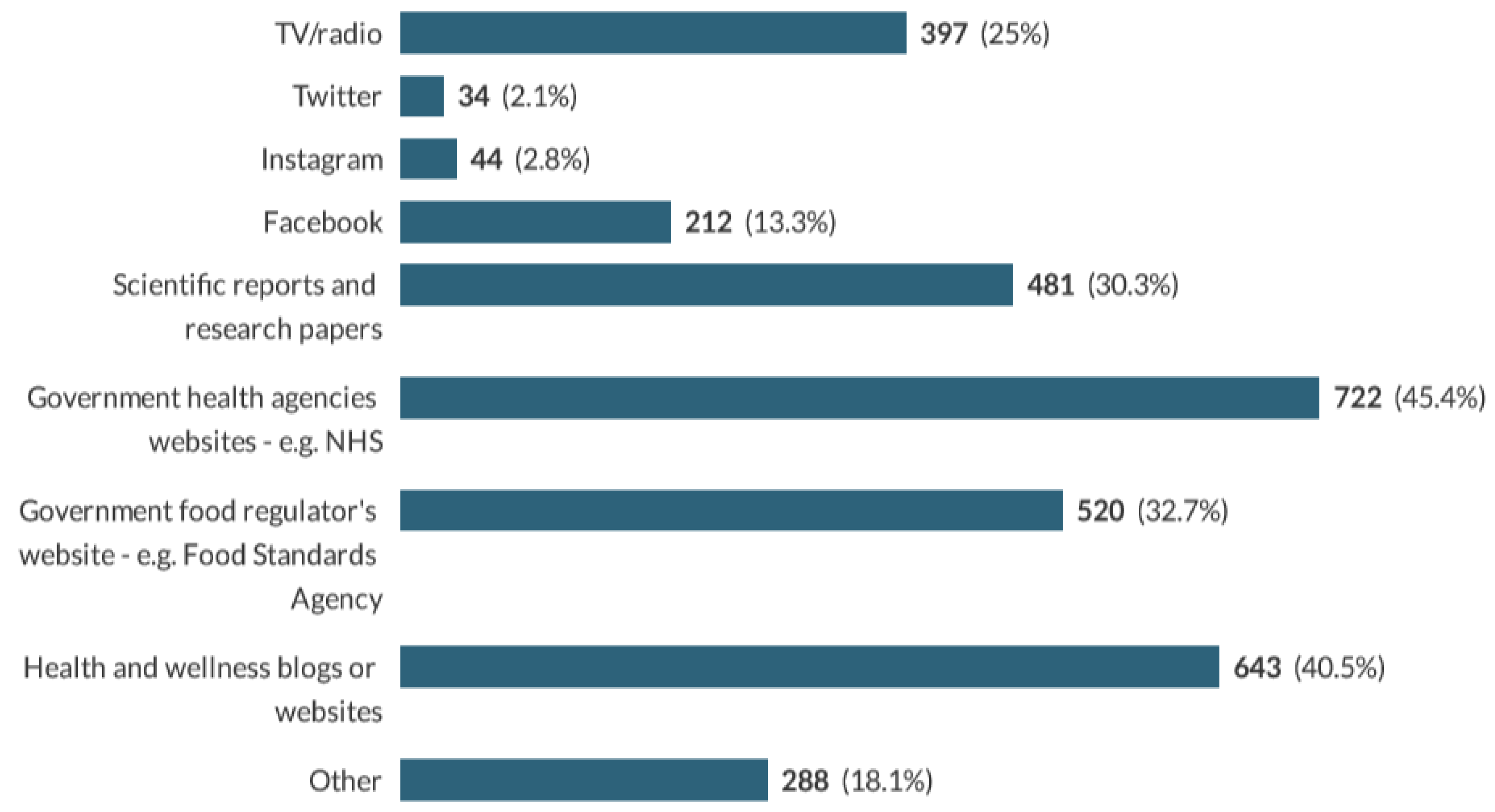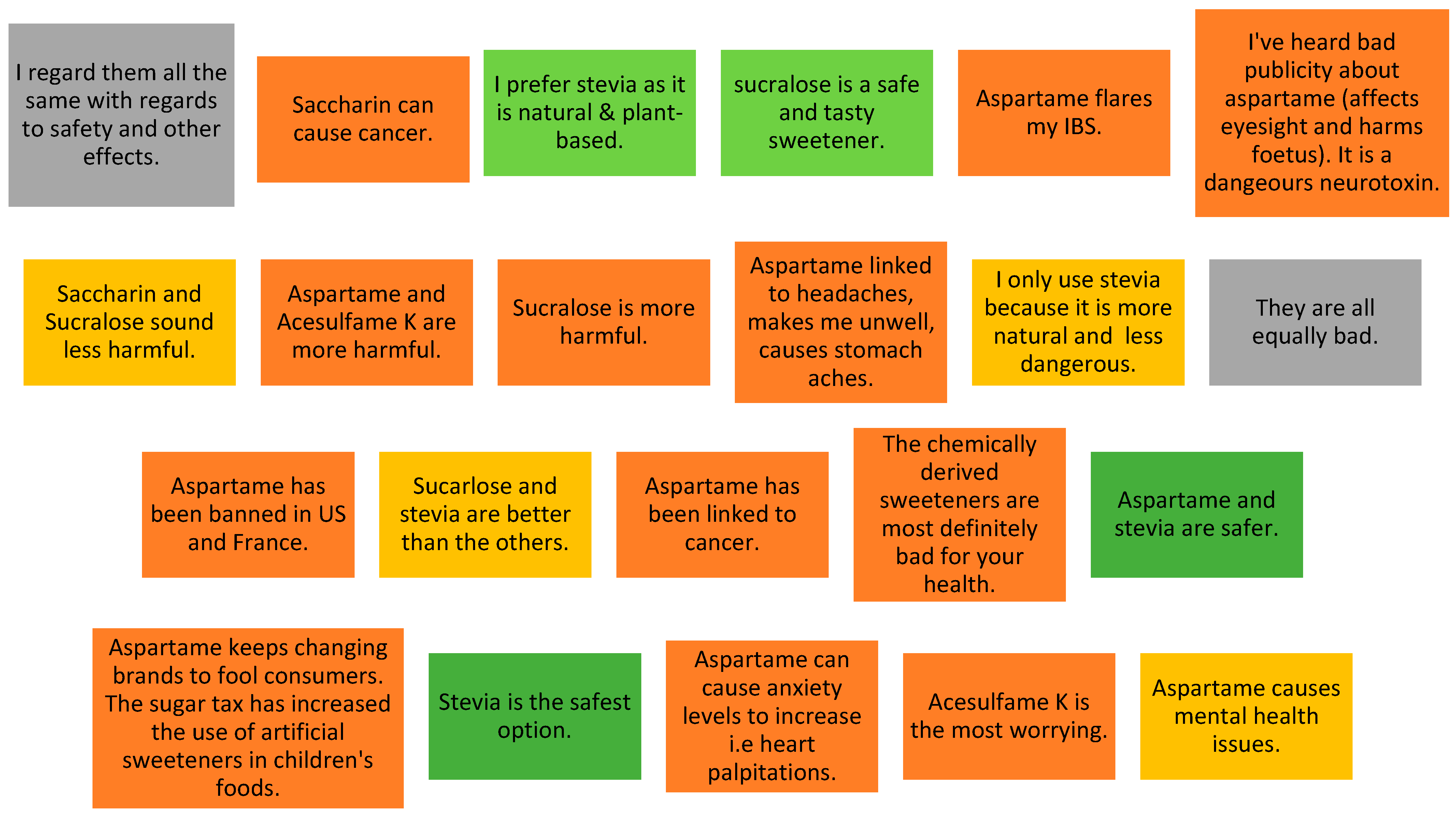Knowledge and Perceptions of Non-Nutritive Sweeteners Within the UK Adult Population
Abstract
1. Introduction
2. Materials and Methods
2.1. Data Collection
2.2. Sample Size Calculation and Statistical Analysis
3. Results
3.1. Source of NNS in Foods and Drinks
3.2. Reasons for Consuming NNS
3.3. Knowledge and Perceptions of Safety and Benefits of NNS
3.3.1. Influence of Age on Perceptions
3.3.2. Influence of Gender on Perceptions
3.3.3. Influence of Profession on Perceptions
3.3.4. Influence of Education Level on Perceptions
3.4. Sources of Consumers’ Knowledge of Benefits and Safety of NNS
3.5. Knowledge and Trust in Regulations Surrounding the Use of Artificial Sweeteners
3.6. Attitudes towards Different Types of Sweeteners
3.7. Knowledge Dissemination
4. Discussion
- Educate consumers and health professionals that “natural” does not necessarily imply “healthy”. Additionally, as stevia derives from plant sources, we suggest avoiding grouping it under the umbrella of “artificial sweeteners”. We also recommend unifying the labelling of these substances to either NNS or LCS across all online resources of professional organisations and regulatory bodies.
- Government health agencies (notably the NHS (National Health Service) in the UK) are held in high esteem in this population, and they could therefore promote easy to access information relating to benefits and risks of NNS, particularly through media, social media and leaflets. The feasibility of these initiatives would evidently need to be further explored.
- The practicality of displaying more information on the benefits of NNS on food packages needs to be investigated.
- There remains a gap in knowledge in research relating to some health impacts of NNS (e.g., on gut microbiota) [4]. Further studies are essential to provide further evidence of the safety and benefits of NNS for health professionals and the public.
Strengths and Limitations
5. Conclusions
Supplementary Materials
Author Contributions
Funding
Institutional Review Board Statement
Informed Consent Statement
Data Availability Statement
Acknowledgments
Conflicts of Interest
References
- Diabetes UK. Available online: https://www.diabetes.org.uk/guide-to-diabetes/enjoy-food/carbohydrates-and-diabetes/sugar-sweeteners-and-diabetes (accessed on 5 January 2020).
- Swithers, S.E. Artificial sweeteners produce the counterintuitive effect of inducing metabolic derangements. Trends Endocrinol. Metab. 2013, 24, 431–441. [Google Scholar] [CrossRef] [PubMed]
- Pepino, M.Y. Metabolic effects of non-nutritive sweeteners. Physiol. Behav. 2015, 152, 450–455. [Google Scholar] [CrossRef] [PubMed]
- Ashwell, M.; Gibson, S.; Bellisle, F.; Buttriss, J.; Drewnowski, A.; Fantino, M.; Gallagher, A.M.; De Graaf, K.; Goscinny, S.; Hardman, C.A.; et al. Expert consensus on low-calorie sweeteners: Facts, research gaps and suggested actions. Nutr. Res. Rev. 2020, 33, 145–154. [Google Scholar] [CrossRef] [PubMed]
- Serra-Majem, L.; Raposo, A.; Aranceta-Bartrina, J.; Varela-Moreiras, G.; Logue, C.; Laviada-Molina, H.; Socolovsky, S.; Bartrina, J.A.; Aldrete-Velasco, J.A.; Sierra, E.M.; et al. Ibero–American Consensus on Low- and No-Calorie Sweeteners: Safety, Nutritional Aspects and Benefits in Food and Beverages. Nutrients 2018, 10, 818. [Google Scholar] [CrossRef]
- Cohen, S.M.; Arai, M.; Jacobs, J.B.; Friedell, G.H. Promoting effect of saccharin and DL-tryptophan in urinary bladder carcinogenesis. Cancer Res. 1979, 39, 1207–1217. [Google Scholar]
- Soffritti, M.; Belpoggi, F.; Degli Esposti, D.; Lambertini, L. Aspartame induces lymphomas and leukaemias in ratsa L’aspartame induce linfomi e leucemie nei ratti. Eur. J. Oncol. 2005, 10, 107–116. [Google Scholar]
- Lim, U.; Subar, A.F.; Mouw, T.; Hartge, P.; Morton, L.M.; Stolzenberg-Solomon, R.; Campbell, D.; Hollenbeck, A.R.; Schatzkin, A. Consumption of aspartame-containing beverages and incidence of hematopoietic and brain malignan-cies. Cancer Epidemiol. Prev. Biomark. 2006, 15, 1654–1659. [Google Scholar] [CrossRef]
- Soffritti, M.; Padovani, M.; Tibaldi, E.; Falcioni, L.; Manservisi, F.; Lauriola, M.; Bua, L.; Manservigi, M.; Belpoggi, F. Sucralose administered in feed, beginning prenatally through lifespan, induces hematopoietic neoplasias in male swiss mice. Int. J. Occup. Environ. Health 2016, 22, 7. [Google Scholar]
- National Cancer Institute. Available online: https://www.cancer.gov/about-cancer/causes-prevention/risk/diet/artificial-sweeteners-fact-sheet#:~:text=Because%20the%20bladder%20tumors%20seen,since%201981%20as%20a%20substance (accessed on 5 January 2020).
- US Food and Drug Administration. Available online: https://www.fda.gov/food/food-additives-petitions/additional-information-about-high-intensity-sweeteners-permitted-use-food-united-states (accessed on 6 January 2020).
- British Dietetic Association. Available online: https://www.bda.uk.com/improvinghealth/healthprofessionals/policy_statements/sweetners (accessed on 6 January 2020).
- Gardner, C.; Wylie-Rosett, J.; Gidding, S.S.; Steffen, L.M.; Johnson, R.K.; Reader, D.; Lichtenstein, A.H. Nonnutri-tive sweeteners: Current use and health perspectives: A scientific statement from the American Heart Association and the American Diabetes Association. Circulation 2012, 126, 509–519. [Google Scholar]
- Gibson, S.; Drewnowski, A.; Hill, J.; Raben, A.; Tuorila, H.; Widström, E. Consensus statement on benefits of low-calorie sweeteners. Nutr. Bull. 2014, 39, 386–389. [Google Scholar] [CrossRef]
- Varela, P.; Fiszman, S. Exploring consumers’ knowledge and perceptions of hydrocolloids used as food additives and ingredients. Food Hydrocoll. 2013, 30, 477–484. [Google Scholar] [CrossRef]
- Bearth, A.; Cousin, M.E.; Siegrist, M. The consumer’s perception of artificial food additives: Influences on acceptance, risk and benefit perceptions. Food Qual. Prefer. 2014, 38, 14–23. [Google Scholar] [CrossRef]
- Roman, S.; Sánchez-Siles, L.M.; Siegrist, M. The importance of food naturalness for consumers: Results of a sys-tematic review. Trends Food Sci. Technol. 2017, 67, 44–57. [Google Scholar] [CrossRef]
- Saraiva, A.; Carrascosa, C.; Raheem, D.; Ramos, F.; Raposo, A. Natural sweeteners: The relevance of food natural-ness for consumers, food security aspects, sustainability and health impacts. Int. J. Environ. Res. Public Health 2020, 17, 6285. [Google Scholar] [CrossRef] [PubMed]
- NHS UK. Available online: https://www.nhs.uk/live-well/eat-well/are-sweeteners-safe/ (accessed on 7 January 2020).
- American Heart Association. Available online: https://www.heart.org/en/healthy-living/healthy-eating/eat-smart/sugar/nonnutritive-sweeteners-artificial-sweeteners (accessed on 7 January 2020).
- Cancer Research UK. Available online: https://www.cancerresearchuk.org/health-professional/cancer-statistics/risk/overweight-and-obesity (accessed on 7 January 2021).
- Romo-Romo, A.; Aguilar-Salinas, C.A.; Brito-Córdova, G.X.; Gómez Díaz, R.A.; Vilchis Valentín, D.; Almeda-Valdes, P. Effects of the non-nutritive sweeteners on glucose metabolism and appetite regulating hormones: Systematic review of observational prospective studies and clinical trials. PLoS ONE 2016, 11, e0161264. [Google Scholar] [CrossRef] [PubMed]
- Le Donne, C.; Mistura, L.; Goscinny, S.; Janvier, S.; Cuypers, K.; D’Addezio, L.; Sette, S.; Catasta, G.; Ferrari, M.; Piccinelli, R.; et al. Assessment of dietary intake of 10 intense sweeteners by the Italian population. Food Chem. Toxicol. 2017, 102, 186–197. [Google Scholar] [CrossRef]
- Buffini, M.; Goscinny, S.; Van Loco, J.; Nugent, A.; Walton, J.; Flynn, A.; Gibney, M.J.; McNulty, B. Dietary intakes of six intense sweeteners by Irish adults. Food Addit. Contam. Part A 2017, 35, 425–438. [Google Scholar] [CrossRef] [PubMed]
- Office for National Statistics UK. Available online: https://www.ons.gov.uk/employmentandlabourmarket/peopleinwork/employmentandemployeetypes/articles/graduatesintheuklabourmarket/2017 (accessed on 18 January 2021).
- Maloney, N.G.; Christiansen, P.; Harrold, J.A.; Halford, J.C.; Hardman, C.A. Do low-calorie sweetened beverages help to control food cravings? Two experimental studies. Physiol. Behav. 2019, 208, 112500. [Google Scholar] [CrossRef]
- Baka, A.; Figgou, L.; Triga, V. ‘Neither agree, nor disagree’: A critical analysis of the middle answer category in Voting Advice Applications. Int. J. Electron. Gov. 2012, 5, 244. [Google Scholar] [CrossRef]
- Wandel, M.; Fagerli, R.A. Consumer concern about food related health risks and their trust in experts. Ecol. Food Nutr. 2001, 40, 253–283. [Google Scholar] [CrossRef]
- Wandel, M. Consumer concern and behaviour regarding food and health in Norway. J. Consum. Stud. Home Econ. 1994, 18, 203–215. [Google Scholar] [CrossRef]
- British Geriatrics Society. Available online: https://www.bgs.org.uk/resources/diabetes#:~:text=Recommendations-,Introduction,years%20have%20diabetes%20(1) (accessed on 21 January 2021).
- Food Standards Agency UK. Available online: https://www.gov.uk/guidance/food-labelling-giving-food-information-to-consumers#tell-the-consumer-about-certain-ingredients (accessed on 7 January 2021).
- Shim, S.-M.; Seo, S.; Lee, Y.; Moon, G.-I.; Kim, M.-S.; Park, J.-H. Consumers’ knowledge and safety perceptions of food additives: Evaluation on the effectiveness of transmitting information on preservatives. Food Control 2011, 22, 1054–1060. [Google Scholar] [CrossRef]





| Number of Respondents (N = 1589) | Percentage of the Population | |
|---|---|---|
| Gender | ||
| Male | 246 | 15.5% |
| Female | 1339 | 84.3% |
| Other | 4 | 0.3% |
| Age (years) | ||
| 18–24 | 110 | 6.9% |
| 25–34 | 276 | 17.4% |
| 35–44 | 367 | 23.1% |
| 45–54 | 441 | 27.8% |
| 55–64 | 286 | 18% |
| 65+ | 109 | 6.9% |
| Ethnicity | ||
| White British | 1414 | 89% |
| White Irish | 34 | 2.1% |
| Other white | 86 | 5.4% |
| Mixed race | 16 | 1% |
| Other | 13 | 0.8% |
| Education | ||
| No formal qualifications | 43 | 2.7% |
| GCSE/O-level | 287 | 18.1% |
| A-Level or Equivalent | 332 | 20.9% |
| Degree level | 547 | 34.4% |
| Postgraduate level | 350 | 22% |
| Other | 30 | 1.9% |
| Profession | ||
| Health-related professions | 209 | 12.9% |
| Managers, directors and senior officials | 198 | 12.5% |
| Professional occupations (other than health-related) | 323 | 20.3% |
| Associate professionals or technical | 57 | 3.6% |
| Administrative and secretarial | 165 | 10.4% |
| Skilled trade | 59 | 3.7% |
| Caring, leisure and other service | 82 | 5.2% |
| Sales and customer service | 94 | 5.9% |
| Student/unemployed/retired | 223 | 14% |
| Other | 179 | 11% |
| Country of residence | ||
| England | 1309 | 82.4% |
| Scotland | 57 | 3.6% |
| Wales | 203 | 12.8% |
| Northern Ireland | 20 | 1.3% |
| Disease history | ||
| Type 1 Diabetes | 18 | 1.1% |
| Type 2 Diabetes | 92 | 5.8% |
| High blood pressure | 208 | 13.1% |
| Heart disease | 32 | 2% |
| Cancer | 52 | 3.3% |
| None of the above | 1266 | 79.7% |
| I Consume Artificial Sweeteners Because They: | Strongly Disagree | Disagree | Neither Agree nor Disagree | Agree | Strongly Agree |
|---|---|---|---|---|---|
| Are tasty | 94 (9.6%) | 191 (19.5%) | 441 (44.9%) | 212 (21.6%) | 44 (4.5%) |
| Are healthier than sugars | 88 (9%) | 180 (18.3%) | 255 (26%) | 360 (36.7%) | 99 (10.1%) |
| Are low in calories | 55 (5.6%) | 33 (3.4%) | 98 (10%) | 393 (40%) | 403 (41%) |
| Satisfy sweet cravings | 78 (7.9%) | 118 (12%) | 236 (24%) | 412 (42%) | 138 (14.1%) |
| Are ingredients in foods and products that I consume | 52 (5.3%) | 36 (3.7%) | 117 (11.9%) | 447 (45.5%) | 330 (33.6%) |
| Question | Strongly Disagree | Disagree | Neither Agree nor Disagree | Agree | Strongly Agree | I Don’t Know |
|---|---|---|---|---|---|---|
| I am aware of the regulation surrounding the use of artificial sweeteners | 203 (12.8%) | 632 (39.8%) | 295 (18.6%) | 303 (19.1%) | 47 (3%) | 109 (6.6%) |
| I am not aware of these regulations as I don’t know where to look for them | 105 (6.6%) | 384 (24.2%) | 374 (23.5%) | 504 (31.7%) | 176 (11.1%) | 46 (2.9%) |
| I am not aware of these regulations as I am not motivated enough to look for them | 108 (6.8%) | 319 (20.1%) | 331 (20.8%) | 609 (38.3%) | 191 (12%) | 31 (2%) |
| I trust the regulatory bodies as their aim is to protect consumers’ health | 67 (4.2%) | 172 (10.8%) | 360 (22.7%) | 765 (48.1%) | 186 (11.7%) | 39 (2.5%) |
| I trust the regulator’s position (such as EFSA and FSA) regarding the safety and benefits of artificial sweeteners | 61 (3.8%) | 155 (9.8%) | 362 (22.8%) | 784 (49.3%) | 171 (10.8%) | 56 (3.5%) |
| Regulations means only a safe amount of these sweeteners are available in foods and drinks | 76 (4.8%) | 227 (14.3%) | 412 (25.9%) | 577 (36.3%) | 140 (8.8%) | 157 (9.9%) |
| All artificial sweeteners have been vigorously tested before being allowed on the market | 96 (6%) | 193 (12.1%) | 422 (26.6%) | 506 (31.8%) | 157 (9.9%) | 215 (13.5%) |
Publisher’s Note: MDPI stays neutral with regard to jurisdictional claims in published maps and institutional affiliations. |
© 2021 by the authors. Licensee MDPI, Basel, Switzerland. This article is an open access article distributed under the terms and conditions of the Creative Commons Attribution (CC BY) license (http://creativecommons.org/licenses/by/4.0/).
Share and Cite
Farhat, G.; Dewison, F.; Stevenson, L. Knowledge and Perceptions of Non-Nutritive Sweeteners Within the UK Adult Population. Nutrients 2021, 13, 444. https://doi.org/10.3390/nu13020444
Farhat G, Dewison F, Stevenson L. Knowledge and Perceptions of Non-Nutritive Sweeteners Within the UK Adult Population. Nutrients. 2021; 13(2):444. https://doi.org/10.3390/nu13020444
Chicago/Turabian StyleFarhat, Grace, Fleur Dewison, and Leo Stevenson. 2021. "Knowledge and Perceptions of Non-Nutritive Sweeteners Within the UK Adult Population" Nutrients 13, no. 2: 444. https://doi.org/10.3390/nu13020444
APA StyleFarhat, G., Dewison, F., & Stevenson, L. (2021). Knowledge and Perceptions of Non-Nutritive Sweeteners Within the UK Adult Population. Nutrients, 13(2), 444. https://doi.org/10.3390/nu13020444






